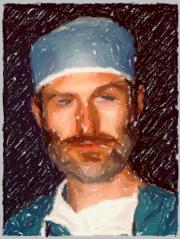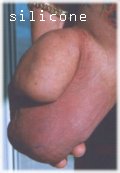
 Dr. Robert H. Stubbs is an accomplished plastic surgeon and artist,
Board Certified in Plastic Surgery in Canada and in the United States as
well as belonging to numerous professional organizations. In 1984
Dr. Stubbs opened Toronto, Canada's first ambulatory cosmetic surgery
centre, the Cosmetic Surgicentre. You can visit Dr. Stubbs online at
the Surgicentre's web page at
www.psurg.com or contact the
centre via telephone at (416)927-9900 or via their automated info
line at (416)927-7195.
Dr. Robert H. Stubbs is an accomplished plastic surgeon and artist,
Board Certified in Plastic Surgery in Canada and in the United States as
well as belonging to numerous professional organizations. In 1984
Dr. Stubbs opened Toronto, Canada's first ambulatory cosmetic surgery
centre, the Cosmetic Surgicentre. You can visit Dr. Stubbs online at
the Surgicentre's web page at
www.psurg.com or contact the
centre via telephone at (416)927-9900 or via their automated info
line at (416)927-7195.
BERFORE/AFTER MEDICAL PHOTOS IN THIS INTERVIEW ARE COURTESY OF DR. ROBERT H. STUBBS. MORE PHOTOS OF PROCEDURES PERFORMED BY HIM MAY BE FOUND IN THE SURGICAL GALLERY ON HIS WEB PAGE. PHOTOS OF STEVE HAYWORTH AND JOE AYLWARD ARE TAKEN FROM "BODY ART #23". AFRICAN BODYART PHOTO TAKEN FROM "AFRICA ADORNED". ALL OTHER PHOTOS FROM "BME".
STUBBS: The reason that I said, "come on in, and I'd be glad to answer your questions," is these are all excellent questions, and times change. When I went to med. school, back in '73, cosmetic surgery was a bad word. It was something that respectable doctors didn't do, because as a doctor you're trained to help sick people; it wasn't seen as healing. It was an aberration and was seen as a money grubbing business type of thing that doctors who weren't good enough to make it in the real system (the academic system) did. But by the time I finished, we realised that by modifying or improving the body, it could make a tremendous difference in how people perceive themselves (in their self- image). This is so much so that some illnesses are created by the constant worry about one's body image. But as with most things, most things that are different, it takes time for acceptance, or it goes away in time and it's considered to be a fad. Many of the professors that taught me at the university would say, "oh no, cosmetic surgery is bad," when those same professors went to private little places and did it on the side, but no one knew about it. I knew about it because I was asked to assist you see. So there was a certain element of hypocrisy.
You're probably stretching the limits of what North American society finds "tolerable".
BME:
Yeah, that's a safe assumption. But these things are
acceptable in some places. Subincisions for example -- They
are accepted in Australia.
BME:
Well, Aboriginal people.

BME:
So beauty is on a cultural rather than personal
level?
But the subincision destroys a certain element of the penis, the spiral valve, which allows you to urinate properly.

STUBBS: It sprays.
BME:
Well, people can sit down.
You don't need a penis. These days penises are redundant! You can have needle aspiration of sperm from your testicles, you can have your child by artificial insemination of your female partner, and in a sense, you can do away with the penis.
BME:
Well, the motivation behind a subincision is that it
opens up the urethra to more stimulation; it feels better.
That's why -- people who are doing them are seeing them as
enhancing procedures.
BME:
If a surgeon did go ahead and do subincisions, what sort
of professional risk would they be at?
BME:
If you went to them with the idea of a subincision, and
said, "here's this procedure, I think it's a good idea for
these reasons", what would the steps be for getting
"authorisation", since you went through a similar process
with the penis lengthening surgery?
BME:
But I can show an equally long history of subincisions,
albeit not a medical one.
BME:
Most of the people doing it are doing it on themselves. I
can walk into any drugstore and buy anaesthetic, scalpels,
and anything I need to do surgery on myself.

STUBBS: I think he's probably at high risk, because in our society, certainly here [in Canada], only nurses, dentists, and doctors can violate the skin into the deeper layer (into the subcutaneous). That's a boundary past which the law starts acting. You can be tattooed because it's going into the dermis. You can have hair removed by electrolysis because that again is in the skin, but you go under the skin, which is what some of these things are, and you're into that grey area.
BME:
But piercing goes under the skin in some cases.
BME:
At least professional piercing studios have got
autoclaves and operating at some basic level of
sterility.
A woman, one of her tests came back Hepatitis C positive, and I had to turn her down for surgery.
BME:
Why is that?
BME:
When you're charging forty dollars for a piercing, that's
not really an option.
When I do labia reductions (labia minora reductions) on women, it involves in some who are very grossly redundant, going around the clitoris and down the other side, simply because the redundancy heads around that way. The word circumcision is synonymous with what's done in Africa, to actually remove everything, and I don't think you're associates are into that extreme...
BME:
It's certainly a very small subculture.
That's not a law that doctors passed, that's one that society has passed and doctors are expected to enforce. Any woman that comes to my office and has had an African circumcision and it's done in Canada, I have to report that woman to the Officer of Health, the College, and the Police. Just like if you have HIV, I have to report you. Or if you are sexually abused I have to report you.
BME:
Right now, that "line", as far as operations go, is drawn
only at female genital mutilation?
The College of Physicians and Surgeons licenses doctors, but they also have the power to put people in jail that are doing things that doctors normally do. So in other words, they are there to protect the public, whether it be from a bad doctor, or someone else.
BME:
Like if I started doing surgery out of my home.
BME:
I know there are people (not doctors) doing castrations
in Toronto on a client basis.
BME:
But there are some people (in the US) who have managed to
convince their doctors to perform it for psychological
reasons.
BME:
In most of the cases it's done in a fetish environment,
or because the people feel out of control due to the
testosterone, or due to fear of various cancers.
BME:
Do you get a lot of people coming to you with unusual
requests?
As far as evaluation, I've been a doctor for longer than twenty-five years. It's almost like a driver: He knows when that person's going to pull out in front of him - You just know it's going to happen, so you turn. I can get a pretty good clue beforehand which patients I feel comfortable accepting for surgery.
BME:
I was asked recently about penile reduction. Is that an
option?
He was within the range of normal (normal is a bell curve). I turned him down. The risk is too great. When you do a surgical procedure, there is risk there. The patient has not got enough education, experience in life to understand the limits of that risk.
To make one smaller, I'd just reverse the process of the lengthening. There many operations that accidentally make the penis smaller. One is putting rods in it; there's fibrosis, there's scarification. But I did not want to do an operation which in a sense I felt was too risky for someone that was within normal limits. But you can turn around and when someone else comes in, and they have small breasts, but I think the risk to benefit ratio is better in their interest. There's no black and white -- If there was, it wouldn't be a very interesting world.

STUBBS: Probably long before they did that, the Orientals were into that. I'll show you. [Shows me a C-shaped piece of a rubber- like substance]. There. That's what I took out of one man, and that goes around the neck of the penis. That was put in in the Orient. Just a standard thing they do over there.
BME:
And that's something you could only get away with
there?
If I put the genital implant in here, and he developed a complication, I would probably in a court of law lose, and I might have a problem with my license.
BME:
Could you even refer someone to a doctor in Asia that
could do it?
Four or five years ago I had men calling me that wanted penis enhancement and I said that I was not aware of anyone doing it, I had never been trained in doing it, and I certainly wouldn't feel comfortable doing it without adequate training. But I had access to the medical literature and I looked it up. There are two things that I felt might help people, and one was girth. And because I'd been aspirating fat out for many years and injecting it back in women's faces and other areas to plump up things. I told one patient who was crippled by the size of his penis that this might help, but he'd be the first. I didn't feel that putting part of his body back in his body was a major risk and he accepted and the result was good. But with others we found the fat might shift, or wouldn't live, and there were irregularities and unpredictability. We have an improvement on that now called dermal fat grafting. So that area there hasn't been much of a kafuffle about.

BME:
I was told that it's primarily average or larger than
average men coming in?
| Plastic surgery traditionally has been a problem solving speciality. When there is a problem out there, but no one seems to know what the solution is, or a complication, then there is a group of artistic, creative doctors that say, "OK, my training is a broad basis of things. I'm not just a bone doctor, I'm not just a kidney doctor, I'm sort of a doctor that's been trained in all those specialities, and looks at problems." Plastic surgeons seemed to be the group that during the war, guys would get pieces shot off, and we've saved their life, but how can we integrate them back into society? In come the plastic surgeons and they take a piece here, a piece there, they put the person back together with a result that does not look too bad. |
[At this point Dr. Stubbs shows me a portfolio of photographs -- the following comments were in regards to those photos] For ten years I taught academic plastic surgery, which was trauma, reconstructive, and cosmetic. Here's a drug addict that shot up in the wrong vein; that's gangrene. He got the boots put to his face, broke all the bones. He got his hand in the machine that makes the shingles for the roof and couldn't find the off switch -- That's his groin [grafted onto his wrist]. In the past, his hand would have been cut off. There's no way of saving that when you've got no coverage. Chainsaw that jumped back. More cancers. The scars are there. His scar is better because his skin is looser. He's got sun-damaged old tight skin, but just the same, he can now go out in public, whereas that fungating cancer there certainly gave people a bit of indigestion at the meal table. Dog bite - now he could put a ring in that, but again, his mother wasn't happy about that.
Worst skin cancer, melanoma. Ear. Now you see, some of the things that your group are doing would be considered by Western standards deforming. And a plastic surgeon looks at something which is a cancer which to you looks like a little scab, but under a microscope this eating well away part of his ear. I could just cut it out and it would leave a hole. Now, if that was someone from your subculture, they'd be happy with that. But 99.9% of the people in North America would not be, and so they ask me, please, can you make my ear look acceptable again? You see, you disturb a lot of people. I don't have to tell you that.

You see, some of the risk of what you're doing, or what people similar to yourself who are fully aware of what they're doing at a time in their life that they think that that's great and a form of expression, later on their circumstances change, and then they ask me for help. I had a man who was a genius, he dropped out of school early, he ran with the drug culture, he was in a motorcycle gang. He just didn't find enough stimulation in life, except sort of on the wild side, and then he realised that there were other things that were equally stimulating, and that was academic pursuits. He went to university, did well, and got into medicine, which is an unlimited field as far as stimulation. Unfortunately he had "69" tattooed on his earlobe. I cut it out because in those days we didn't have a laser that was specific for that pigment and I took some skin from behind his ear and put a patch on it. It looked a little bit like a burn but that was socially acceptable. He was fully aware that that tattoo, in that location, would severely limit his advancement in now his new profession.
What you do is irreversible. You can never make it normal again. You can try and put it back close to normal, but you can never make it normal again. Some of the things I worry about, the sterility and the transfer of disease, that can be circumvented with the appropriate precautions. But other things are permanent that may become a problem later in life you have to seriously consider.
I have a patient who is an executive, he was a handsome guy. He looked mesomorphic, fit, tailored suit, Armani, the works, everything. When he was on the football team, they were drinking and he decided to get his ear pierced and although he did not wear anything in that and hadn't for five years, he now had short cropped hair and was moving up the ladder in the corporation, and he was bright and they were wanting to move him along, but was entering the rooms and talking with his head turned a bit because he was very self-conscious about these two little holes. I cut them out and patched them up. Now it blends in. Some people have a crease in that area, fortunately, so it looks more like a crease. If someone really looked, they could see something had been done. Even the stigma of having had a pierced ear was more than he could tolerate in his ascent up the corporate ladder.
BME:
I think that's a very important warning for people.
BME: In a lot of cases piercing makes people much more comfortable with their bodies. There body might be fine, but a little thing makes them feel better about it.
STUBBS: It's a form of adornment. But just as what I do can be carried to an extreme, and I'm the only one that can determine the limit, because I have the right legally to do that. I can refuse a patient. What you do, or the body modification subculture does, could be carried to an extreme to the detriment of the person. And I don't know where that limit is. In our society, it's over there, and in other societies, it's way over there.
Time will tell. (Five years from now...) I sort of joked to one of the staff here, maybe we should open one of the rooms for piercing and tattooing so at least we can supervise the sterility and how it's done. It's like abortion -- if it's being done to the detriment of people, that they're dying of haemorrhage and infection, it was legalized and then done in hospitals.
Medicine has come a long way because of certain anaesthetic techniques. Prior to anaesthesia, the things that I do would be just incomprehensible. Because we have LSD which is what we use to dissociate the patients mind from their body and then use freezing on them that lasts up to eight hours.
BME:
What's the difference between street LSD and medical
grade LSD?
Medical grade LSD can have the same psychedelic effects, or it can have bizarre effects if it's a mixture of things or impure. We use pure grade LSD. The patient is floated out for five minutes so we release their mind from their body and freeze the area we're going to work on with a local. They drift back into awareness, but now they're frozen. The LSD is a quick trip out and back and by then they're frozen. The freezing is painful -- the long-acting freezing is unpleasant and may involve a lot of needling or needling in areas that people aren't accustomed to. This allows us to get a part of the body numb so that things can be done to it.
BME: Obviously you wouldn't (couldn't) recommend this, but a person who does want to get some of these unusual surgical procedures done, is their only avenue going to Mexico or India or places where the doctors can get away with it?
STUBBS: I would think so.
BME:
Outside of just saying "don't do it" about warnings would
you offer? If it's something that they really want, and
there isn't a mainstream medical avenue for achieving
it...
BME:
In all the people that I know, I don't know of any
serious medical problems arising directly from one of these
procedures.
All the doctors in Toronto knew when I had a massive complication because I personally went with the patient from here to the Toronto General when he returned the next day with a huge haematoma. He was a Chinese chap that took oriental medication that was probably spiked with Aspirin or something that caused a bleeding problem and didn't tell us. But there was obviously something going wrong when he came back the next day. Everyone in Toronto heard about that through the medical grapevine, and if they hadn't heard, I publicised it, as it was totally unexpected. Patients now are grilled, we ask them now about garlic, because there's a component in garlic which may affect bleeding, we ask them about ginseng, we ask them about high dose vitamin E.

STUBBS: Well, liquid silicone is uncontrolled. It was never approved for general use. It was authorised among ten or twenty doctors for experimental purposes so they could follow it over a period of time but some people got hold of it and started injecting it for the purpose of building up chins, lips, or noses, and because it had impurities in it, it caused phenomenal allergic fibrous reactions, which literally destroyed the tissues that it was put into.
BME:
Since that was due to impurities, if you got pure,
medical grade silicone, would these problems go away?
BME:
So basically for safe implants in polymers you're limited
to Teflon?
BME:
It doesn't bond to the tissue?
The problem is we can't catch them in the act usually, and it requires a person to complain. Often the person who's had it done feels somewhat responsible because they said all right and feel terribly foolish. If someone dies then the coroner, society, takes over. If the person stays alive, very few will go out and turn it into a big court case because they are partly responsible for their own illness.

STUBBS: It's called skin expansion. We do that to cover defects. It didn't take a genius, but the guy that discovered it I guess watched his wife get pregnant and said, I need to close a defect from a burn patient, and if my wife can stretch her skin over nine months, maybe I can do the same thing.
BME:
Right now those are Teflon, but he's planning on putting
in coral to have it bond to the bone.
BME:
Sometimes bone spurs creating horns occur in humans
through accident?
BME:
I'm not asking for instructions, but is that something
this guy could do?
Implants have been put in the scalp before by people that want to hold a hairpiece on, and they invariably get infected. The scalp is one of these multi-layered tissues that if you get infection in one of the layers it spreads.
BME:
Dr. Anthony Pignatora, a doctor in New York is putting
titanium snaps in to hold on toupees.
BME:
Do they offer a direct line for infection into the
skull?
BME:
[Showing photos of the "Metal Mohawk"] He's successfully
healed and it's been about a year now.
BME:
When doing implants, do you do something like a spot
test, implant a little piece of the material to check
that?
BME:
Are breast implants your most common procedure?
BME:
But the lawsuits were still successful.

STUBBS: Liposuction may be the most common. Certainly for women it's the most common procedure I do. As far as the penis lengthening, I've been analysing my statistics since I got back from China and of course when I got back it was a novel and new procedure and men were rushing to sacrifice themselves no matter how experimental they were told it was. That volume went up and came down and now it has probably stabilised at the true need and desire level. We did patient 395 or 396 yesterday, so probably by the end of the month we'll hit 400. I do two or three a week. We're probably closer to sixty to eighty per year.
BME:
You mentioned you don't do girth and length in one
operation.
BME:
I've seen other surgeons that are willing to do that.

STUBBS: He wasn't my great grandfather, but you follow the family tree back, there's old George sitting up on one of the branches. It wasn't anything that people kept saying, "you're the spitting image of that guy two hundred years ago." Art was my major all through high school and I taught it as a summer job.
BME:
I guess that gives you an advantage as a plastic
surgeon?
BME:
In relation to that, how does your Cosmetic Surgicentre
serve people?
Return to BME/People